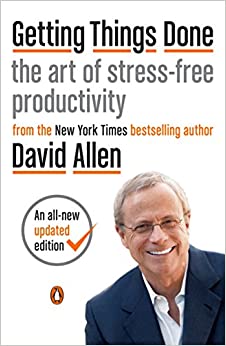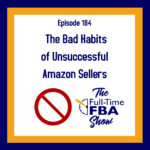As Amazon sellers, it can be pretty easy to unknowingly fall into some bad habits that keep us from making as much money as possible. During today’s episode, we’re uncovering some of the things Amazon sellers commonly do (or don’t do) that keep us from being successful at selling on Amazon. It might be tempting to keep making these mistakes, but these bad habits can easily stunt your growth and even cause you to lose profits.
Listen today to hear our thoughts on scheduling, sourcing decisions, outsourcing, and more. You’ll also learn about our free five-day workshop on accelerating your income through selling on Amazon and where to find it. Thanks for listening!
Listen on the podcast player below.
Like what you hear? Tell a friend… and be sure to leave us a rating and a review. Here’s how.
 Key points from Episode 184:
Key points from Episode 184:
- What might come to mind when you think about bad habits.
- Why it can be a problem to only source within your comfort zone.
- The importance of scheduling Amazon reselling activities.
- Resources for planning well and getting things done.
- How a Keepa graph can transform your business and help you to avoid mistakes.
- Leveraging the power of outsourcing to grow faster.
- Important checks you need to do when you are sourcing on Amazon.
- An invitation to a free five-day workshop: The Amazon Income Accelerator Workshop.
 Links and resources mentioned in this episode:
Links and resources mentioned in this episode:
- The Amazon Income Accelerator Workshop
- How to Read and Understand Keepa Graphs
- Getting Things Done by David Allen
- The Perfectionism Project on Instagram
- Sam Laura Brown
- Selling Oversized Items for Supersized Profits on Amazon
Right-click here and save as to download this episode to your computer.
![]()
 The Amazon Income Accelerator Workshop
The Amazon Income Accelerator Workshop
Free 5-day online workshop focused on how to realistically make a full-time income selling on Amazon
We’re going to show you…
- Why Amazon is the best place to focus your time and energy to grow a reselling business that brings in a full-time income.
- How to find unlimited inventory to sell on Amazon for consistent profits.
- How to make the best inventory sourcing decisions (what to resell, what to pass on, how deep to go on a buy, how to replenish your inventory, etc.).
- The full-time income success path and how you can snowball your Amazon profits.
- How to turn impossible roadblocks into meaningless speed bumps.
- And so much more!
Back to the main page for The Full-Time FBA Show
More Episodes from the Full-Time FBA Show podcast:
Don’t miss an upcoming episode! Subscribe, download episodes, and review the Full-Time FBA Show:
-
-
- Subscribe on iTunes
- Follow on Spotify
- Follow on Amazon Music (or just ask Alexa to “play The Full-Time FBA Show podcast”)
- Follow on iHeartRadio
- Subscribe on Podbean
- Subscribe on Podbay
- Subscribe on Podchaser
-
![]()
Episode 184 Transcript:

[INTRODUCTION]
[0:00:01.8] ANNOUNCER: Welcome to The Full-Time FBA Show. In each episode, it’s our goal to help you turn part-time hours into a full-time income, selling almost anything on Amazon. Now, your hosts of the show, Stephen and Rebecca Smotherman.
[WELCOME]
[0:00:21.7] STEPHEN: Welcome to Episode Number 184 of The Full-Time FBA show. Today, we’re going to be discussing bad habits of unsuccessful Amazon sellers and to talk through this with me today for you is someone I know who has no bad habits, my wife, Rebecca.
[0:00:36.3] REBECCA: Oh my word.
[0:00:37.0] STEPHEN: Did I score any points there?
[0:00:38.4] REBECCA: I don’t know if you scored points or causing people to be skeptical of what you’re saying because that does not sound accurate.
[0:00:46.3] STEPHEN: All right, we all have bad habits, right? So we’re going to discuss the ones that impact our Amazon business and cause us not to make as much money as we could if we overcame those bad habits. Let’s get into it on today’s episode.
[DISCUSSION]
[0:01:00.5] REBECCA: Yeah, I think it’s more accurate to say that we all have bad habits, including your deepest loved one, that you think can do no wrong. I mean, I don’t know. I think we all probably think that our loved ones can do wrong.
[0:01:12.5] STEPHEN: Absolutely.
[0:01:13.0] REBECCA: We see their bad habits more than anybody. So you could be thinking of anything when we talk about bad habits. Something may come to mind, like scrolling on social media too much.
[0:01:21.5] STEPHEN: Guilty, I‘m guilty on that.
[0:01:23.9] REBECCA: Yeah. At times, we all are, we’re eating too many sweets, that one’s mine, that’s my big downfall, I have a sweet tooth. Eating too late at night can be a bad habit if you do it too regularly and it messes up your sleep or your digestion or just the habit of not doing something, skipping love things that you know you should be doing.
Not working out as often as you should could be a good example of that and I could go on and on. I don’t need to. You know what all the things are. I’m sure if you’re anything like me, when I say bad habit, something comes to your mind that I don’t need to point out for you.
But today we’re going to be discussing some of the bad habits that many Amazon sellers might have that are causing them not to find success that they’ve been looking for when it comes to selling on Amazon.
[0:02:08.9] STEPHEN: So the first habit we’re going to talk about today is only sourcing inventory in your comfort zones. There’s a quote that is, if you keep doing what you’ve always done, you’ll keep getting what you always got.
So obviously, we’re not going to see any change, any growth, if we keep doing things that we’ve always done before and comfort zone sourcing is good. I mean, that’s why it’s comfortable. We found some success, we can get some consistency and comfort zone, that’s really good but it’s also good to get out of your comfort zone because if you’re just source in your comfort zones then you’re just going to not have any growth with your sourcing skills.
So it’s always a good idea to branch out, trying to source outside of different categories or different stores or different-sized items. There’s people who love making money on Amazon selling standard-sized items and they’re missing out on oversized items that are profitable. We have a podcast about that, so we’ll put that in the show notes about sourcing oversize and if we don’t, we’ll plan one soon.
So sourcing in your comfort zone, again, most times when you plan a sourcing outing, you walk to the places you’re comfortable, where you found success. So get out of your comfort zone, when you are outside of the comfort zone, that’s where the magic happens. So let’s get over that bad habit and start sourcing new places in new ways.
[0:03:27.9] REBECCA: The second bad habit that comes to mind for me is not scheduling out your Amazon FBA business activities. There’s a quote that you’ve probably heard from various sources, “what doesn’t get scheduled, doesn’t get done” and this is super important.
The more you get into running your Amazon business and the more you’ve got going on in your life, whether it is another business that you’re part of or a job that you have, or whether you are running a family that you’re very involved in taking care of other people’s activities if you have any type of caretaker activities, then you’ve got a lot going on, and so you’ve got to get things scheduled out, and that includes your Amazon FBA business activities.
If you don’t schedule it, you could end up putting things off that are really important for your business, and it could be holding you back so that you don’t get the kind of growth that you’re expecting because you’re just not planning things well. This is something that I’ve really tried to finetune in my own business, in my own schedule over the last several months. I kind of gotten in a rut of not planning very well and I recently started following Sam Laura Brown.
She has a podcast and she’s active on Instagram. Her account is called, The Perfectionism Project, and whether or not you’re a perfectionist and that causes you problems with getting things done, you really could benefit from some of the things that she has to say or somebody else who has a lot of information about getting things done and how to plan.
[0:04:59.5] STEPHEN: The book, Getting Things Done, I read that and it’s really good. It’s not by her, it’s by another author but I just remembered that as you said that. Getting Things Done is the name of the book, it’s really good.
[0:05:09.2] REBECCA: Yeah, check out the book, Getting Things Done, and then check out Sam Laura Brown, The Perfectionism Project. She has Power Planning is a big central part of what she does, that’s why I even brought her up is Power Planning and I’ve started doing her power hour. I can’t say it the way she does because she’s got this really awesome Australian accent where she says power hour in a way that I just can’t duplicate.
But anyway, spending a little bit of time upfront in your week where you plan out what you’re going to do for your FBA business, where you put some activities on your calendar and you make sure that everybody in your household knows, “Hey, this is the time I’m going to be working in my business” and that they can plan around that and that they can respect those plans.
It goes a long way toward getting more stuff done and toward growing in your Amazon business. So that’s the second bad habit that really stands out to me, that is one that I am really working on is not scheduling out your FBA activities.
[0:06:00.3] STEPHEN: So take some time today, get a pen and paper, a calendar or something, and schedule out your most important Amazon activities so that they get done soon. So bad habit number three, ignoring your Keepa Graphs, and if you have no idea what Keepa is then I’m going to revolutionize your Amazon business because Keepa is a program online that tracks almost every single item on Amazon’s price history, sales rank history, buy box history.
So much information that can help you make smarter sourcing decisions and you can use the item’s history to better predict the future of how the sales velocity is going to be, what the pricing is going to be because the prices are going up and down all the time. So Keepa Graph is awesome and if you are outsourcing and you’re not looking at a Keepa Graph, then you might be making a mistake that’s going to waste money in your Amazon business and waste time because you have to deal with repricing or calling an inventory item back or losing money completely on the sale.
There’s lots of different ways things could go wrong if you ignore a Keepa Graph. If you want to learn how to use a Keepa Graph the right way, I’ve got a link with a free video showing you how to kind of get started with learning Keepa at fulltimefba.com/readkeepa and I admit, even though I even put a whole course together on Keepa, sometimes I can get lazy and not check Keepa Fraphs and then I see where things go wrong and it bites me in the butt but Keepa can help you and it helps you just really avoid a lot of mistakes and helps you make better decisions in your Amazon business in so many ways more than just sourcing and pricing as well.
But yeah, for the link to kind of get started with Keepa for free, fulltimefba.com/readkeepa. So if you’ve heard about Keepa and you’ve never used it, try it out. If you know about Keepa, keep looking at a Keepa Graph when you source. It just takes a few extra seconds and can really help your sourcing in your Amazon business.
[0:07:51.3] REBECCA: The fourth bad habit that we’re going to talk about today is one that I bring up as often as I can and that is the bad habit of doing everything in your business all by yourself. If they ever make a drinking game based on The Full-Time FBA Show Podcast, it would be every time Stephen says Keepa and I say ‘outsourcing’, right?
[0:08:12.5] STEPHEN: That’s right, yes.
[0:08:13.5] REBECCA: So when you’re doing everything by yourself and you’re not outsourcing, you are setting yourself up to grow so much slower and possibly even fail and want to quit your business. It is an okay strategy when you are just starting out to do everything yourself and your business because you are trying to learn how the full system works and because you’re limited in your money that you can spend on extra expenses but it is not sustainable if you want long-term growth.
You have to incorporate outsourcing as early as possible into your business strategy in order to grow. If you don’t, you’re going to end up being burned out and there is just not going to be the freedom that you can experience if you have somebody else working with you on your business. There is so many ways you can outsource, we have other podcasts and blog articles on that. We’ll put some links in the show notes so that you can get some ideas of where to start.
But just know that if you’re far enough along into your business and you’re still thinking, “No, I got this. I can do it all myself” that’s a bad habit that you need to step back and look at and say, “Is this something that I need to work on?”
[0:09:18.0] STEPHEN: Yeah, one thing that Rebecca and I are always asking in our Amazon business and in other areas of our life as well is, “Is there anyone else who should be doing this besides me?” and there are certain things. I mean, almost everything can be outsourced in your Amazon business, but start small, start letting go. We can help you through it.
So bad habit number five is sourcing items without doing a few important checks. I mean, there are certain times when we’re outsourcing, and we just love the fact that we found something that has a good sales rank and it’s profitable. We just put it in our cart and just keep moving on, and we might miss out on a few things like maybe the item that we found is not really in Amazon’s description of new condition.
Maybe you know, that’s sealed in fact resealed, but there’s some scratches on the box or one of the corners is dinged in. Well, that doesn’t go along with Amazon’s definition of what new should be. New should be gift-quality, brand new condition, and if something is scratched up, that’s not gift-quality. If something has a ding in the corner, that’s not gift quality. So check the conditions when you are sourcing.
Another thing that you could miss out on when you’re sourcing is looking at the Amazon sales page to make sure that the items that you are selling are an exact match. I’ve gotten in trouble with this a few times. I found a board game on sale at Coles I believe, and I ended up finding out that even though it had the same UPC, it was like a cheaper version.
So instead of offering this boardgame with a nice chrome pewter type of pawns for the boardgame, the Coles version had a cheaper plastic pawn version of that boardgame, and so, of course, it was cheaper for me to buy it at that condition, but if tried to sell it on Amazon with the sales page that had the pewter chrome type of pawns for the boardgame, that’s not an exact match.
So you want to make sure that not just the UPC matches but the description matches too because you can get in trouble with that and get negative feedback or someone might even accuse you of selling a counterfeit item because it is not an exact match, it’s a cheaper version of it. So do your due diligence and make sure that the sales pages match the items that you are actually sourcing to sell on Amazon.
So that’s bad habit number five, sourcing inventory items without doing a few important checks when you’re sourcing and so I want to close up this episode by letting you know if you are a seller on Amazon or if you are thinking of starting to be a seller on Amazon and you want to either kick these bad habits or you want to make sure you don’t even start out with these bad habits because there’s so many more bad habits to avoid.
And instead, you want to learn the ins and outs of how to make a full-time income selling on Amazon, then we want to invite you to a free five-day online workshop called The Amazon Income Accelerator Workshop, where we’re going to walk you through how to realistically make a full-time income selling on Amazon in 2023. The link to sign up fulltimefba.com/workshop.
[0:12:11.8] REBECCA: In this free online workshop, we’re going to show you how to find potentially, unlimited sources of inventory to sell on Amazon and how to set up your Amazon business to earn consistent and predictable profits, that is huge. So that you can get to the point where you can sell on Amazon and make a full-time income.
We’re going to share the Full-Time FBA success path and how you can realistically snowball your Amazon profits into that full-time income. There’s so much we can’t wait to share with you in the Amazon Income Accelerator Workshop. Again, the link to the five-day online workshop is, fulltimefba.com/workshop.
[CLOSING CONVERSATION]
[0:12:51.5] REBECCA: Thank you so much for joining us for this episode of The Full-Time FBA Show. As a reminder, the show notes for this episode and the transcript and all of the links that we’ve mentioned can be found at fulltimefba.com/184 because this is episode number 184.
[0:13:08.1] STEPHEN: And next week on the show, we’re going to be talking about successfully selling on Amazon during an economic downturn. We see what’s going on in the world and in the United States and we want to help you have the right kind of mindset and the right strategies to successfully sell on Amazon during this economic downturn. We’ll see you next week on The Full-Time FBA Show.
[OUTRO]
[0:13:31.3] ANNOUNCER: That is all for this episode of The Full-Time FBA Show. So head over to fulltimefba.com/podcast, where you will find the show notes and links from this episode. While you’re there, subscribe to our newsletter where you’ll get several free downloads of our popular and helpful Amazon FBA resources. Now, take action on what you have learned today, so you can find success at turning part-time hours into a full-time income with Amazon FBA.
[END]


Leave a Reply